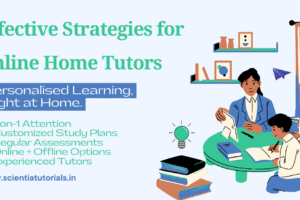Focused Learning: Tips for Home Tutors on Managing Distractions
Introduction
In the world of home tutoring, one of the biggest challenges is managing distractions that can hinder a student’s learning experience. Distractions can arise from various sources, including technology, environmental factors, or even the student’s mindset. As a home tutor, it’s essential to create an effective learning environment that minimizes these distractions and promotes focus and engagement. This article explores practical strategies and tips for home tutors to manage distractions, enabling students to achieve their academic goals.
Understanding Distractions in Home Tutoring
Types of Distractions
Distractions can be broadly categorized into two types:
- External Distractions: These include noise from outside, interruptions from family members, electronic devices, and clutter in the study area.
- Internal Distractions: These are mental distractions, such as a wandering mind, stress, or personal issues that can divert a student’s attention away from learning.
Recognizing the types of distractions your students face is the first step in effectively managing them.
The Impact of Distractions on Learning
Distractions can significantly affect a student’s ability to concentrate, retain information, and engage with the material. When students are unable to focus, it can lead to frustration, decreased motivation, and poor academic performance. As a tutor, addressing distractions is critical not only for the immediate tutoring session but also for the student’s long-term success.
Strategies for Managing Distractions
1. Create a Designated Learning Space
A dedicated learning space is vital for minimizing distractions. Ensure that the study area is quiet, well-lit, and free from interruptions.
Key Considerations:
- Location: Choose a spot away from high-traffic areas and noise.
- Comfort: Use comfortable furniture that supports good posture.
- Organization: Keep the study area organized with essential materials within reach.
2. Establish a Routine
Establishing a consistent tutoring routine helps students know what to expect and can significantly improve their focus. Routines create a sense of stability and can mentally prepare students for learning.
Routine Tips:
- Set Specific Times: Schedule regular tutoring sessions at the same time each week.
- Consistent Start and End Times: Begin and end sessions on time to instill discipline.
- Incorporate Breaks: Short breaks can help refresh a student’s mind and keep distractions at bay.
3. Limit Electronic Distractions
In today’s digital age, electronic devices can be significant sources of distraction.
Tips for Limiting Distractions:
- Use Apps Wisely: Encourage the use of educational apps while minimizing access to social media and games during tutoring sessions.
- Set Boundaries: Create rules regarding the use of devices, such as keeping phones on silent or in another room during the session.
- Incorporate Technology: Use educational technology to engage students but balance its use with traditional learning methods.
4. Foster a Growth Mindset
Encouraging a growth mindset can help students overcome distractions caused by frustration or fear of failure. When students believe that they can improve through effort, they are more likely to stay engaged.
Growth Mindset Strategies:
- Celebrate Effort: Acknowledge hard work, not just correct answers, to reinforce the idea that persistence leads to success.
- Encourage Questions: Create a safe environment for students to ask questions and express confusion, helping them focus on learning rather than worrying about making mistakes.
5. Set Clear Goals
Setting clear, achievable goals can help students remain focused on the task at hand. When students know what they need to accomplish during a session, they are less likely to be sidetracked by distractions.
Goal-Setting Tips:
- Short-Term Goals: Establish specific, short-term goals for each session, such as completing a certain number of practice problems.
- Long-Term Goals: Discuss long-term academic goals with students to keep them motivated and focused on their overall progress.
6. Encourage Mindfulness Techniques
Mindfulness can help students manage internal distractions, such as stress or anxiety. By teaching mindfulness techniques, tutors can help students improve their focus and self-awareness.
Mindfulness Practices:
- Deep Breathing: Encourage students to take deep breaths before starting a session to calm their minds.
- Visualization: Use visualization techniques to help students picture their learning goals and the steps needed to achieve them.
7. Utilize Engaging Teaching Methods
Engaging teaching methods can capture students’ attention and reduce distractions. The more involved students are in their learning, the less likely they are to be distracted.
Engaging Techniques:
- Interactive Activities: Use hands-on activities, games, and group discussions to promote engagement.
- Real-Life Connections: Relate lessons to real-world scenarios to make the material more relevant and interesting.
8. Communicate with Parents
Involving parents in the learning process can help reinforce focus and minimize distractions. Keep parents informed about their child’s progress and encourage them to create a supportive learning environment at home.
Parent Communication Tips:
- Regular Updates: Provide parents with updates on their child’s progress and areas of improvement.
- Home Environment: Suggest ways parents can create a conducive learning environment, such as reducing noise during tutoring sessions.
9. Addressing Behavioral Issues
Sometimes, distractions stem from behavioral issues that need to be addressed.
Strategies for Addressing Behavior:
- Set Expectations: Clearly outline behavior expectations at the beginning of each session.
- Positive Reinforcement: Use positive reinforcement to encourage desired behaviors and discourage distractions.
10. Evaluate and Adapt
Regularly evaluate the effectiveness of your strategies and adapt as necessary. Each student is unique, and what works for one may not work for another.
Evaluation Tips:
- Feedback: Solicit feedback from students about what helps them focus and what distracts them.
- Adjust Strategies: Be willing to try new techniques or modify existing ones based on student needs and preferences.
Conclusion
Managing distractions in home tutoring is crucial for fostering a productive learning environment. By implementing these strategies, home tutors can help students minimize external and internal distractions, allowing them to focus on their studies.
Creating a dedicated learning space, establishing routines, limiting electronic distractions, fostering a growth mindset, and utilizing engaging teaching methods are just a few ways to enhance focus and engagement. Remember, the key to effective tutoring lies not only in imparting knowledge but also in creating an environment where students can thrive academically. By addressing distractions and fostering a positive learning atmosphere, tutors can significantly impact their students’ educational journeys, paving the way for success.



